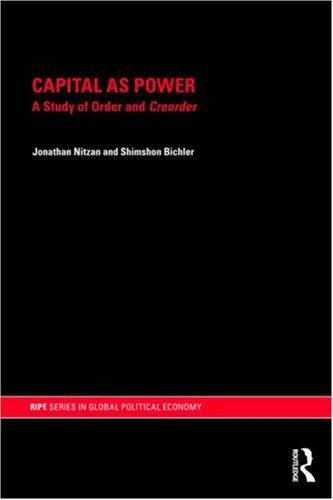In Capital As Power Jonathan Nitzan and Shimshon Bichler launch an attack on both mainstream and Marxist theories of capitalism by focusing on one of the oldest theoretical conundrums in the discipline of political economy — the theory of capital. While the work clearly fits into the tradition of radical political economy it is not easy to place it in any one school, and this for very good reason; the authors are trying to create a new approach to the study of society. The release of this highly ambitious book is aptly timed, for as the global political-economic crisis unfolds and existing theories and paradigms come into question a space will be created in which new theoretical alternatives might be welcomed.
For Nitzan and Bichler, “the secret to understanding [capital] accumulation…lies not in the narrow confines of production and consumption, but in the broader processes and institutions of power,” the implication being that capital is not an economic category anchored in material reality, as both mainstream and Marxist theories maintain, rather it is a “symbolic representation of power.” “Power” in the sense they employ it does not mean “economic power” or “political power” but “organized power at large.” Most people will undoubtedly find this puzzling.
Academic departmentalization and liberal ideology have made it such that we normally think of society as broken up into separate, though overlapping systems. The “economic” system is different than the “political” in that markets and business are institutionally separate from the state and government. Each system operates according to its own logic, pursues different goals, utilizes different means, has its own discourse and is housed in different departments in the university. This conceptual separation might be intuitively comforting and theoretically tidy, but in order to follow their argument we must suspend this bit of conventional wisdom.
As Nitzan and Bichler see it, mainstream and Marxist political economy have a difficult time explaining the quantitative architecture of capitalism — the price system — because the core concepts and categories used to explain it were generated in the 19th century and so predate the emergence of phenomena like big government, big business and big labour. At the core of capitalist societies, they say, is the drive to accumulate capital and this manifests itself as “an ongoing struggle to restructure society against opposition…the form of the process is the quantitative redistribution of ownership, its content the qualitative transformation of power relations.”
As the sub-title indicates, to create order or “creorder” is the ability to impose order against resistance, and this ever-present tension between force and counter-force means that change is institutionalized under capitalism. The architecture of prices, then, is the quantitative manifestation of this change and reflects a qualitative power process in which absentee owners or “investors” engage in a distributional struggle over (corporate) ownership claims and their associated streams of future earnings.
Some will likely find their claims outlandish to the point of being conspiratorial while others might see it as a highly innovative paradigm shift in the study of society. What cannot be called into question is the seriousness, scope or ambition of this work. Characteristic of their style, the authors combine deep historical perspective with a highly interdisciplinary approach to the study of capitalism, as evidenced by continuous references to subjects as diverse as modern physics and literature. The book is geared towards heterodox political economists of all sorts, students of political economy and those outside the university system who are willing to engage with their work. For a subject that can often be heavily jargon-laden, Nitzan and Bichler do a remarkable job of keeping their explanations and examples as simple and clear as possible. Activists and progressives outside the academy who possess the requisite patience and commitment will be able to work their way through it, though the technical components of their argument will make serious demands of them.
The book begins and ends on an optimistic note and one gets swept up in the enthusiasm that “a better world is possible.” Indeed, they are at pains to point out that the logic of capitalism is neither natural nor inevitable; it is a human institution that can be changed. This work has the potential to be explosive, if only for radicals, activists and progressives and could represent a sea-change in the study not only of political economy, but of society more generally.–Jordan Brennan
Jordan Brennan studies under Jonathan Nitzan. He is pursuing a doctorate in political economy and political theory at York University and is a Lecturer in the Department of Liberal Arts and Sciences at George Brown College.




